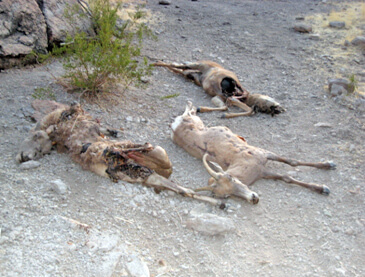 Photo
Credit AZGFD Photo
Credit AZGFD
This From Arizona Game & Fish Department
Aug. 5, 2009
Feds Seek Comment On Draft EA; Proposed Action Will Allow Needed Management
PHOENIX — They are as much an icon of the Southwest as Wyatt Earp, yet the desert bighorn sheep, known for their head-to-head crashing battles and ability to defy gravity by clinging to rocky cliffs, have experienced staggering population declines on the Kofa National Wildlife Refuge.
Continued monitoring of the public’s bighorn sheep population on the Kofa NWR has state and federal wildlife agencies concerned for the future of this historic herd, whose population crashed from an estimated high of 812 animals in 2000 to a record low of less than 400 in just six years.
Why is this population of sheep so important?
“A driving force behind the original establishment of the Refuge was the protection of desert bighorn sheep (Ovis canadensis mexicana), and significant management emphasis remains on maintaining the bighorn sheep population,” as stated in a U.S. Fish and Wildlife Service letter dated Aug. 4, 2009, in reference to the 1939 Executive Order (#8039) that established the Kofa.
The Kofa NWR sheep population has played a critical role in reversing the decline of desert bighorn sheep for more than 50 years. The herd is a historic source population for re-establishing, supplementing, or expanding other sheep populations across the Southwest, in many cases bringing back this incredible species to places where they were extirpated.
“A wide range of outdoor enthusiasts—wildlife watchers, hikers, hunters, photographers, tourists—are able to enjoy the desert bighorn sheep in many parts of the state and the Southwest,” said Pat Barber, the Yuma regional supervisor for the Arizona Game and Fish Department. “Those experiences are made possible by 50 plus years of collaborative translocation efforts by wildlife agencies, landowners and hunter/conservation organizations.”
Some of the more popular destinations that have received sheep from the Kofa herd in the past are the Superstition Mountains, Aravaipa Canyon Wilderness, the Galiuro Mountains, and the San Andres National Wildlife Refuge in New Mexico. There are a number of areas in Arizona that are slated to receive bighorn sheep translocations, including the Pusch Ridge Wilderness, the Mineral Mountains, Big Horn Mountains, Buckeye Hills, and others.
Unfortunately, translocations using sheep from the Kofa were discontinued in 2005. Translocations using animals from the Kofa herd will not resume until the population approaches the long-term population level of 600-800 sheep. The department’s sheep translocation efforts from other source populations continue, but at a reduced rate without the once highly productive Kofa herd as a source.
“A key factor to the herd’s future is managing for the best success in reproduction. Desert bighorn sheep have low birth and survival rates, and any additive mortality to females and their lambs quickly affects the herd’s ability to increase,” said John Hervert, Wildlife Program Manager.
What’s the urgency?
Although managers are working to address several issues that might limit sheep recovery, such as water availability, disease and human disturbance, predation is a growing concern.
Past surveys indicated that, historically, mountain lions were virtually non-existent or only transient guests around the Kofa region. However, in recent years, a number of lions have become frequent users on and around the Kofa, which is having a greater predation effect on the bighorn sheep population during a time when they are already struggling. This new dynamic to the region is requiring the need to address this issue.
Over the past five years, the Arizona Game and Fish Department, in cooperation with the U.S. Fish and Wildlife Service, has used modern technology and equipment to build an extensive data set on mountain lion predation in the Kofa region. Biologists recorded and analyzed data on nearly 100 predations through this monitoring effort.
For example, in less than six months, one mountain lion has killed 14 bighorn sheep in the Kofa predation management area. At its current pace, which is notably more aggressive than the documented average for other collared lions in the Kofa area, this lion could remove 37 bighorn sheep annually. To put this in perspective, surveys of annual yearling recruitment for the herd on the Kofa NWR is only 39 animals.
Hervert added, “Once a localized wildlife population has zero recruitment or less, meaning it’s not replacing lost animals from standard mortalities, it’s just a matter of time before you will lose that population.”
Moreover, officials report three to five other mountain lions prey on wildlife in the area, which would compound the predation impact drastically and continue the herd’s decline.
“The proposed predation management plan does not set out to eliminate lions from the Kofa, but to manage the level of predation,” said Barber. “Mountain lions are a valued game species in Arizona, and are managed as an important part of Arizona’s fauna and to provide mountain lion hunting recreation opportunity while maintaining existing occupied habitat and the present range of mountain lions in Arizona.”
Worth noting, the mountain lion population in Arizona is neither threatened, endangered, or at risk, and they are the most broadly distributed large mammal species in North America.
Adaptive management tools
Due to this rapid decline of the critical Kofa bighorn sheep herd and the increased rate of predation, the U.S. Fish and Wildlife Service has prepared a draft environmental assessment (EA) to implement management strategies for mountain lions to meet the refuge’s purpose and objectives for desert bighorn sheep.
Implementing the plan for “Limiting Mountain Lion Predation on Desert Bighorn Sheep on the Kofa National Wildlife Refuge” is critical. The process started more than 15 months ago and the anticipated completion date has changed three times. The original estimated EA completion date was October 2008. In April 2009, the date was extended to October 2009. With the announcement of the EA scoping period, the anticipated date of completion is now March 2010.
The Arizona Game and Fish Department during this time has continued to institute a self-imposed moratorium on removing offending lions, first for 12 months (six months longer than the first anticipated completion of the EA), and once again for three more months to accommodate the completion of the EA. That moratorium ended July 31. The longer this process takes, the more detrimental it will be to the health and sustainability of the Kofa bighorn sheep herd.
The 60-day public scoping period for the U.S. Fish and Wildlife’s draft EA is open now through Friday, Oct. 2. The public is encouraged to learn more about this dire condition for their wildlife and then provide comment. Wildlife agencies are charged with the management of wildlife species, but wildlife is held in the public’s trust.
For an extensive amount of literature, investigative reports, management plans, and more about desert bighorn sheep, the Kofa NWR and predator management, visit www.azgfd.gov/kofa and select “references.”
Comments for the U.S. Fish and Wildlife Service to be entered into the record must be submitted in writing to KofaLionComments@fws.gov or to 9300 E. 28th Street, Yuma, AZ 85365. A copy of the Draft Environmental Assessment is available by visiting www.fws.gov/southwest/refuges/arizona/kofa.
The U.S. Fish and Wildlife Service’s proposed action is “Alternative B” and the Arizona Game and Fish Department is also supporting this action.
The Arizona Game and Fish Commission will be briefed on the EA process and current conditions of the Kofa bighorn sheep herd at its public meeting on Friday, Aug. 7 in Phoenix, at 5000 W. Carefree Highway. For those who are unable to attend the meeting, the department will be implementing a pilot program to Webcast the proceedings at www.azgfd.gov/commissioncam. For a copy of the commission meeting agenda, visit www.azgfd.gov/pdfs/inside_azgfd/agenda/2009/Aug7-8.pdf.
Dinghy Digest ®
|
















































